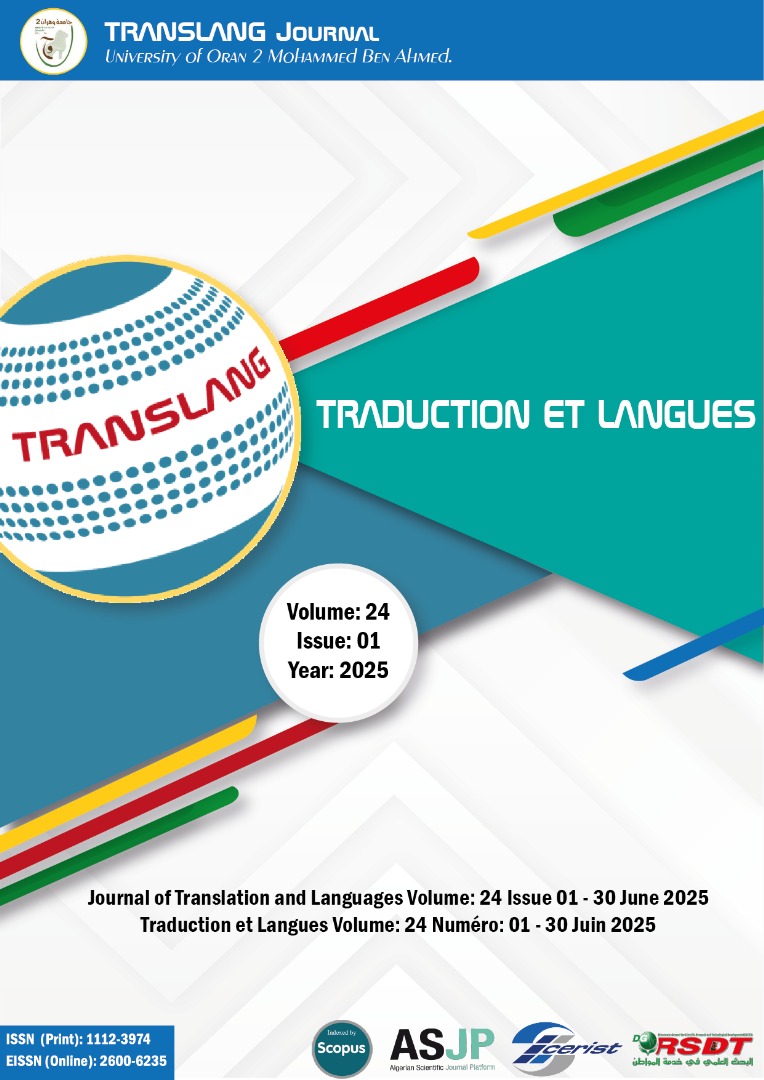AI-assisted Interpreting: Valuable Tool for Professional Interpreters or Job Displacement?
Main Article Content
Abstract
Today, Artificial Intelligence (AI) has permeated across diverse disciplines, professional sectors, and recreational activities. Translation and interpreting are two sectors in which AI is becoming increasingly important. With more and more companies incorporating AI into their means of production or services, it is common for many language professionals to wonder whether their job will one day be replaced by a machine. This question has been a relevant issue since the 18th Century with the contributions of philosophers and scientists, who anticipated notions of computer science. However, in recent years, the concern about the future of professional interpreters has come up again due to the advances in AI. In light of the growing controversy and concern surrounding computer-assisted interpreting (CAI) and translation (CAT), this study aims to verify the reliability of AI applications in interpreting, focusing particularly on the positive and negative aspects of AI use in communicative language exchanges. Our specific purpose is to demonstrate that human interpreters will continue to deliver high-quality work that is tailored to the socio-cultural context of those involved in the communication process. To this end, the study explores recent developments in AI-driven interpreting technologies, such as neural machine translation (NMT) engines and real-time speech recognition systems, assessing their effectiveness in comparison with human interpreters. Employing both qualitative and quantitative methodology —such as case studies and user Through qualitative and quantitative analysis, including case studies and user feedback— the research identifies significant limitations of AI systems, particularly in managing complex discourse, cultural references, nuances, and emotional intelligence. Furthermore, it considers ethical challenges regarding data privacy, user trust, and accountability. The results show that although AI can provide useful assistance in specific contexts—particularly for routine or low-risk interactions—it falls short in cultural sensitivity and register adaptability; scenarios charged with high-risk consequences, and emotionally attached. Ultimately, the study concludes that AI is unlikely to replace professional interpreters, but rather will serve as a complementary instrument that supports and enhances human expertise in the field.
Metrics
Article Details
References
Cho, J. (2021). Intercultural communication in interpreting: Power and choices. Routledge. https://doi.org/10.4324/9781003179993
Dumont-Perez, S. (2024, February 29). Groundbreaking study reveals combination of acceptance, skepticism about AI and interpretation. Language Line Solutions (blog). https://www.languageline.com/blog
European Commission. (2021). Coordinated plan on artificial intelligence 2021 review. https://digital-strategy.ec.europa.eu/en/library/coordinated-plan-artificial-intelligence-2021-review
Fantinuoli, C. (2019). Interpreting and technology. Language Science Press. https://doi.org/10.5281/zenodo.1493289
Fantinuoli, C. (2023). Towards AI-enhanced computer-assisted interpreting. In G. Corpas Pastor & B. Defrancq (Eds.), Interpreting technologies – Current and future trends (pp. 46–71). John Benjamins. https://doi.org/10.1075/ivitra.37.03fan
Hindsight: Reflections on responses to COVID-19 (Global Risks Report 2021, 16th ed.). https://www3. weforum.org/docs/WEF_The_Global_ Risks_ Report_2021.pdf
Horváth, I. (2022). AI in interpreting: Ethical considerations. Across Languages and Cultures, 23(1), 1–13.
International Organization for Standardization. (2022). Information technology – Artificial intelligence – Artificial intelligence concepts and terminology (ISO/IEC Standard No. 22989). https://www.iso.org/standard/74296.html
International Organization for Standardization. (2023). Translation, interpreting and related technology – Vocabulary (ISO Standard No. 20539). https:// www.iso.org/standard/81379.html
Jorati, J. (2014). Gottfried Leibniz: Philosophy of mind. Internet Encyclopedia of Philosophy. https://iep.utm.edu/leib-ove/
Kohn, M. (2020). Four words for friend: The rewards of using more than one language in a divided world. Yale University Press. https://doi.org/ 10.1080/01434632.2022.2098918
Li, J. (2022). Recent advances in end-to-end automatic speech recognition. APSIPA Transactions on Signal and Information Processing, 11(1). https://doi.org/ 10.1561/116.00000050
McKendrick, J. (2024). Lost in translation: AI chatbots still too English-language centric, Stanford study finds. ZDNET. https://www.zdnet.com/article/business-leaders-are-losing-faith-in-it-according-to-this-ibm-study-heres-why/
Michael, J. R., Held, W. B., & Yang, D. (2024, August). Unintended impacts of LLM alignment on global representation. Paper presented at the 62nd Annual Meeting of the Association for Computational Linguistics, Bangkok, Thailand. https://doi.org/ 10.48550/arXiv.2402.15018
Munteanu, O. (2024). Innovating multilingual interaction: AI’s influence on the translation and interpreting industry. PoliLingua. https://www.polilingua. com/blog/post/artificial-intelligence-translation.htm
Oxford English Dictionary. (n.d.). Scalability. Oxford English Dictionary Online. https://www.oed.com/search/dictionary/?scope=Entries&q=scalability
Pöchhacker, F. (2022). Introducing interpreting studies (2nd ed.). Routledge. htps://doi.org/10.4324/9781003186472
Pöchhacker, F., & Liu, M. (2024). Interpreting technologized: Distance and assistance. Interpreting, 26(2), 157–177. https://doi.org/10.1075/intp.00112.poc
Roy, D. (2021). MIT launches Center for Constructive Communication. MIT Media Lab, via MIT News. https://www.media.mit.edu/articles/mit-launches-center-for-constructive-communication/
Sheikh, H., Prins, C., & Schrijvers, E. (2023). Artificial intelligence: Definition and background. In Mission AI. Research for Policy. Springer. https://doi.org/ 10.1007/978-3-031-21448-6_2
Turing, A. M. (2009). Computing machinery and intelligence. In R. Epstein, G. Roberts, & G. Beber (Eds.), Parsing the Turing test (pp. 23–65). Springer.World Economic Forum.
World Economic Forum. (2023). Jobs of tomorrow: Large language models and jobs. https://www3.weforum.org/docs/ WEF_Jobs_of_Tomorrow_ Generative _AI_ 2023. pdf
Yin, T. (2024). Has the use of AI-translated live captions in simultaneous interpreting changed the role of the interpreter? A study based on professional interpreters’ perceptions. The Translator, 1–18. https://doi.org/ 10.1080/ 13556509.2024.2412923
Ziegler, K., & Gigliobianco, S. (2018). Present? Remote? Remotely present! New technological approaches to remote simultaneous conference interpreting. In C. Fantinuoli (Ed.), Interpreting and technology (pp. 119–139). Language Science Press. https://doi.org/10.5281/zenodo.1493299
